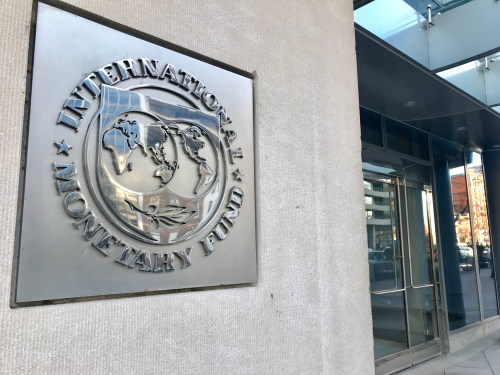IMF Warns Surge in U.S., China Debt Could Have ‘Profound’ Impact on Global Economy
Says U.S. and China, which will continue to see a surge in borrowing if current policies remain in place.
The U.S. and Chinese governments should take action to lower future borrowing, as a surge in their debts threatens to have “profound” effects on the global economy and the interest rates paid by other countries, the International Monetary Fund said Wednesday.
In its twice-yearly report on government borrowing, the Fund said many rich countries have adopted measures that will lead to a reduction in their debts relative to the size of their economies, although not to the levels seen before the Covid-19 pandemic.
However, that is not true of the U.S. and China, which will continue to see a surge in borrowing if current policies remain in place. The Fund projected that U.S. government debt relative to economic output will rise by 70% by 2053, while Chinese debt will more than double by the same year.
The Fund said both countries will lead a rise in global government debt to 98.8% of economic output in 2029 from 93.2% in 2023. The U.K. and Italy are among the other big contributors to that increase.
“The increase will be led by some large economies, for example, China, Italy, the United Kingdom, and the United States, which critically need to take policy action to address fundamental imbalances between spending and revenues,” the IMF said.
The IMF expects U.S. government debt to be 133.9% of annual gross domestic product in 2029, up from 122.1% in 2023. And it expects China’s debt to rise to 110.1% of GDP by the same year from 83.6%.
The Fund said there had been “large fiscal slippages” in the U.S. during 2023, with government spending exceeding revenues by 8.8% of GDP, up from 4.1% in the previous year. It expects the budget deficit to exceed 6% over the medium term.
That level of borrowing is slowing progress toward reducing inflation, the Fund said, and may also increase the interest rates paid by other governments.
“Loose US fiscal policy could make the last mile of disinflation harder to achieve while exacerbating the debt burden,” the Fund said. “Further, global interest rate spillovers could contribute to tighter financial conditions, increasing risks elsewhere.”
A series of weak auctions for U.S. Treasurys are stoking investors’ concerns that markets will struggle to absorb an incoming rush of government debt. The government is poised to sell another $386 billion or so of bonds in May—an onslaught that Wall Street expects to continue no matter who wins November’s presidential election.
While analysts don’t expect those sales to fail, a sharp rise in U.S. bond yields would likely have consequences for borrowers around the world. The IMF estimated that a rise of one percentage point in U.S. yields leads to a matching rise for developing economies and an increase of 90 basis points in other rich countries.
“Long-term government bond yields in the United States remain elevated and sensitive to inflation developments and monetary policy decisions,” the Fund said. “This could lead to volatile financing conditions in other economies.”
China’s budget deficit fell to 7.1% of GDP in 2023 from 7.5% the previous year, but the IMF projects a steady pickup from this year to 7.9% in 2029. It warned that a slowdown in the world’s second largest economy “exacerbated by unintended fiscal tightening” would likely weaken growth elsewhere, and reduce aid flows that have become a significant source of funding for governments in Africa and Latin America.
An unusually large number of elections is likely to push government borrowing higher this year, the Fund said. It estimates that 88 economies or economic areas are set for significant votes, and that budget deficits tend to be 0.3% of GDP higher in election years than in other years.
“What makes this year different is not only the confluence of elections, but the fact that they will happen amid higher demand for public spending,” the Fund said. “The bias toward higher spending is shared across the political spectrum, indicating substantial challenges in gathering support for consolidation in the years ahead, and particularly in a key election year like 2024.”
 Copyright 2020, Dow Jones & Company, Inc. All Rights Reserved Worldwide. LEARN MORE
Copyright 2020, Dow Jones & Company, Inc. All Rights Reserved Worldwide. LEARN MORE
Records keep falling in 2025 as harbourfront, beachfront and blue-chip estates crowd the top of the market.
A divide has opened in the tech job market between those with artificial-intelligence skills and everyone else.
JPMorgan Chase has a ‘strong bias’ against adding staff, while Walmart is keeping its head count flat. Major employers are in a new, ultra lean era.
It’s the corporate gamble of the moment: Can you run a company, increasing sales and juicing profits, without adding people?
American employers are increasingly making the calculation that they can keep the size of their teams flat—or shrink through layoffs—without harming their businesses.
Part of that thinking is the belief that artificial intelligence will be used to pick up some of the slack and automate more processes. Companies are also hesitant to make any moves in an economy many still describe as uncertain.
JPMorgan Chase’s chief financial officer told investors recently that the bank now has a “very strong bias against having the reflective response” to hire more people for any given need. Aerospace and defense company RTX boasted last week that its sales rose even without adding employees.
Goldman Sachs , meanwhile, sent a memo to staffers this month saying the firm “will constrain head count growth through the end of the year” and reduce roles that could be more efficient with AI. Walmart , the nation’s largest private employer, also said it plans to keep its head count roughly flat over the next three years, even as its sales grow.
“If people are getting more productive, you don’t need to hire more people,” Brian Chesky , Airbnb’s chief executive, said in an interview. “I see a lot of companies pre-emptively holding the line, forecasting and hoping that they can have smaller workforces.”
Airbnb employs around 7,000 people, and Chesky says he doesn’t expect that number to grow much over the next year. With the help of AI, he said he hopes that “the team we already have can get considerably more work done.”
Many companies seem intent on embracing a new, ultralean model of staffing, one where more roles are kept unfilled and hiring is treated as a last resort. At Intuit , every time a job comes open, managers are pushed to justify why they need to backfill it, said Sandeep Aujla , the company’s chief financial officer. The new rigor around hiring helps combat corporate bloat.
“That typical behavior that settles in—and we’re all guilty of it—is, historically, if someone leaves, if Jane Doe leaves, I’ve got to backfill Jane,” Aujla said in an interview. Now, when someone quits, the company asks: “Is there an opportunity for us to rethink how we staff?”
Intuit has chosen not to replace certain roles in its finance, legal and customer-support functions, he said. In its last fiscal year, the company’s revenue rose 16% even as its head count stayed flat, and it is planning only modest hiring in the current year.
The desire to avoid hiring or filling jobs reflects a growing push among executives to see a return on their AI spending. On earnings calls, mentions of ROI and AI investments are increasing, according to an analysis by AlphaSense, reflecting heightened interest from analysts and investors that companies make good on the millions they are pouring into AI.
Many executives hope that software coding assistants and armies of digital agents will keep improving—even if the current results still at times leave something to be desired.
The widespread caution in hiring now is frustrating job seekers and leading many employees within organizations to feel stuck in place, unable to ascend or take on new roles, workers and bosses say.
Inside many large companies, HR chiefs also say it is becoming increasingly difficult to predict just how many employees will be needed as technology takes on more of the work.
Some employers seem to think that fewer employees will actually improve operations.
Meta Platforms this past week said it is cutting 600 jobs in its AI division, a move some leaders hailed as a way to cut down on bureaucracy.
“By reducing the size of our team, fewer conversations will be required to make a decision, and each person will be more load-bearing and have more scope and impact,” Alexandr Wang , Meta’s chief AI officer, wrote in a memo to staff seen by The Wall Street Journal.
Though layoffs haven’t been widespread through the economy, some companies are making cuts. Target on Thursday said it would cut about 1,000 corporate employees, and close another 800 open positions, totaling around 8% of its corporate workforce. Michael Fiddelke , Target’s incoming CEO, said in a memo sent to staff that too “many layers and overlapping work have slowed decisions, making it harder to bring ideas to life.”
A range of other employers, from the electric-truck maker Rivian to cable and broadband provider Charter Communications , have announced their own staff cuts in recent weeks, too.
Operating with fewer people can still pose risks for companies by straining existing staffers or hurting efforts to develop future leaders, executives and economists say. “It’s a bit of a double-edged sword,” said Matthew Martin , senior U.S. economist at Oxford Economics. “You want to keep your head count costs down now—but you also have to have an eye on the future.”
In the remote waters of Indonesia’s Anambas Islands, Bawah Reserve is redefining what it means to blend barefoot luxury with environmental stewardship.
Ophora Tallawong has launched its final release of quality apartments priced under $700,000.
























